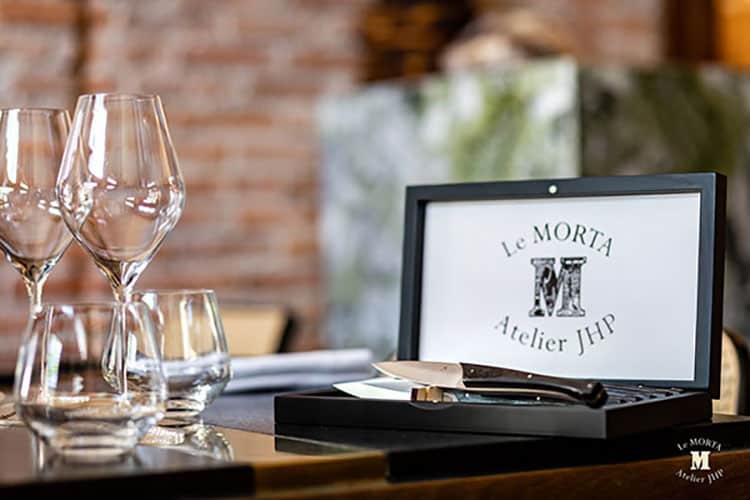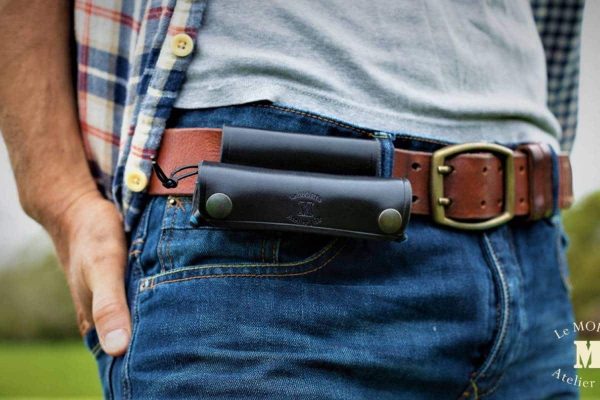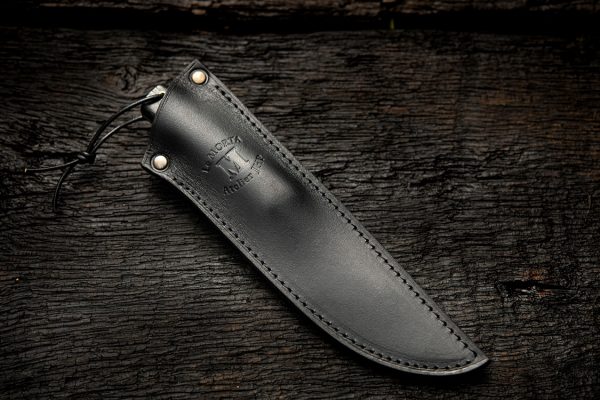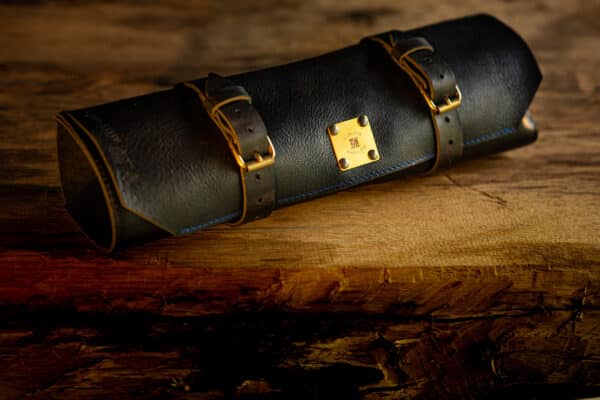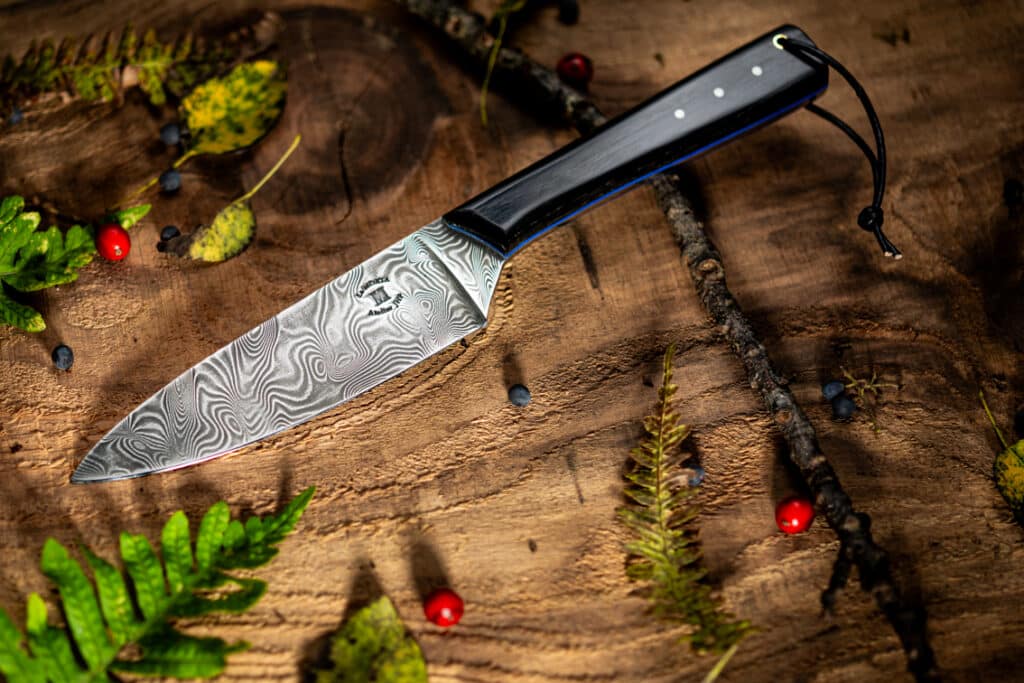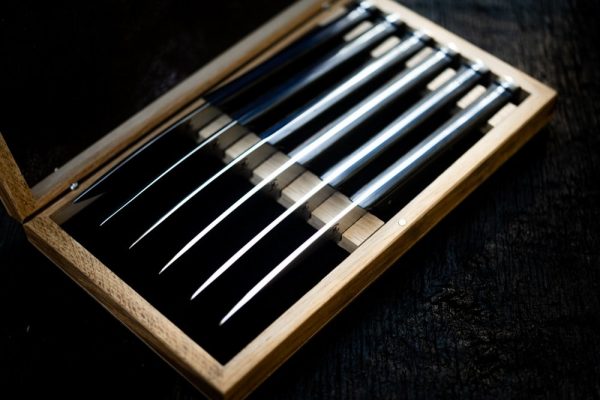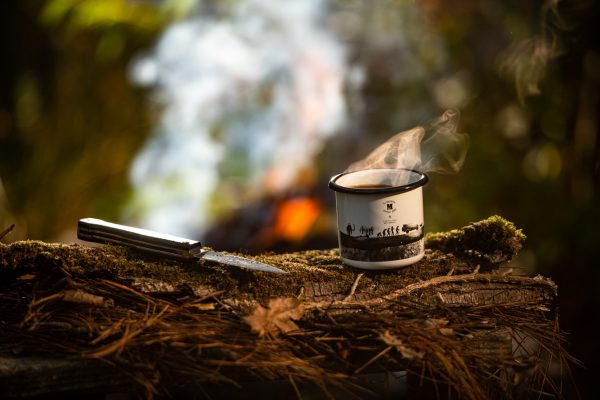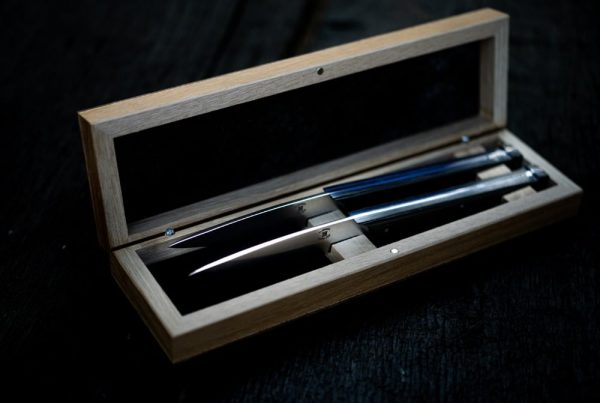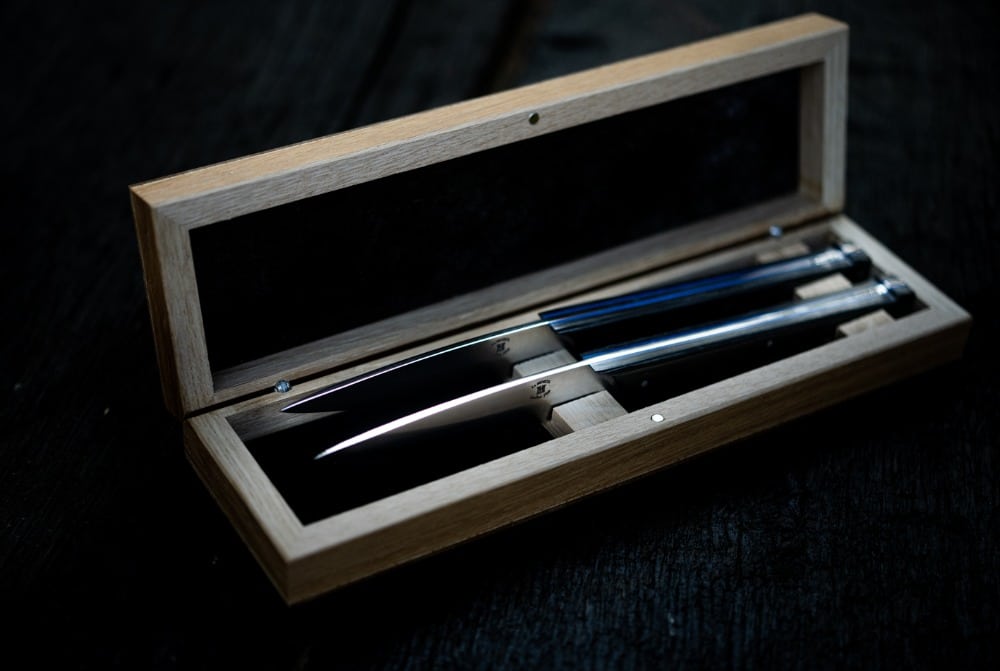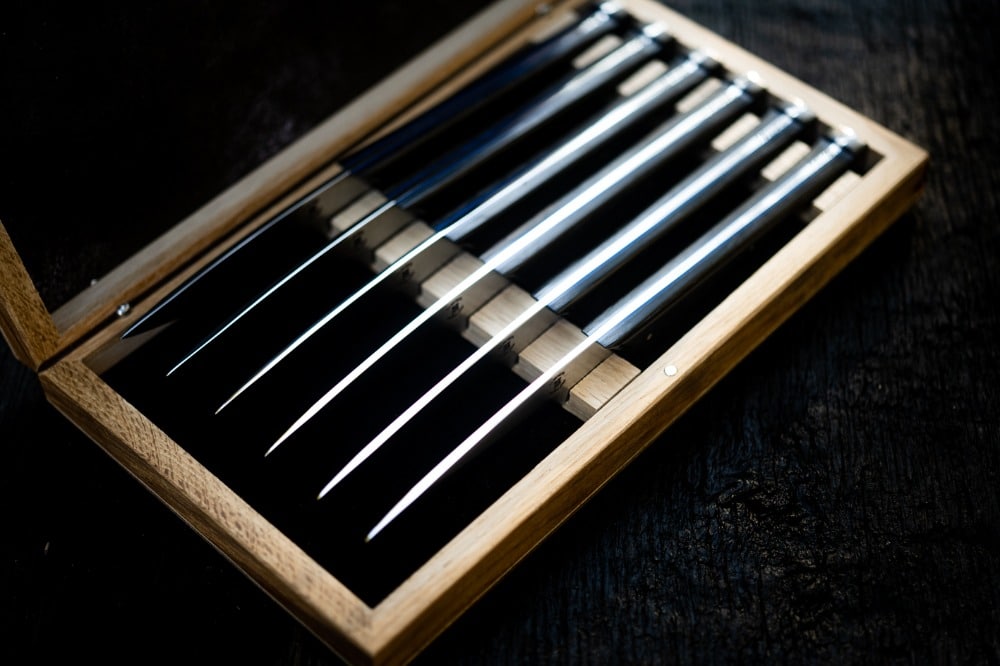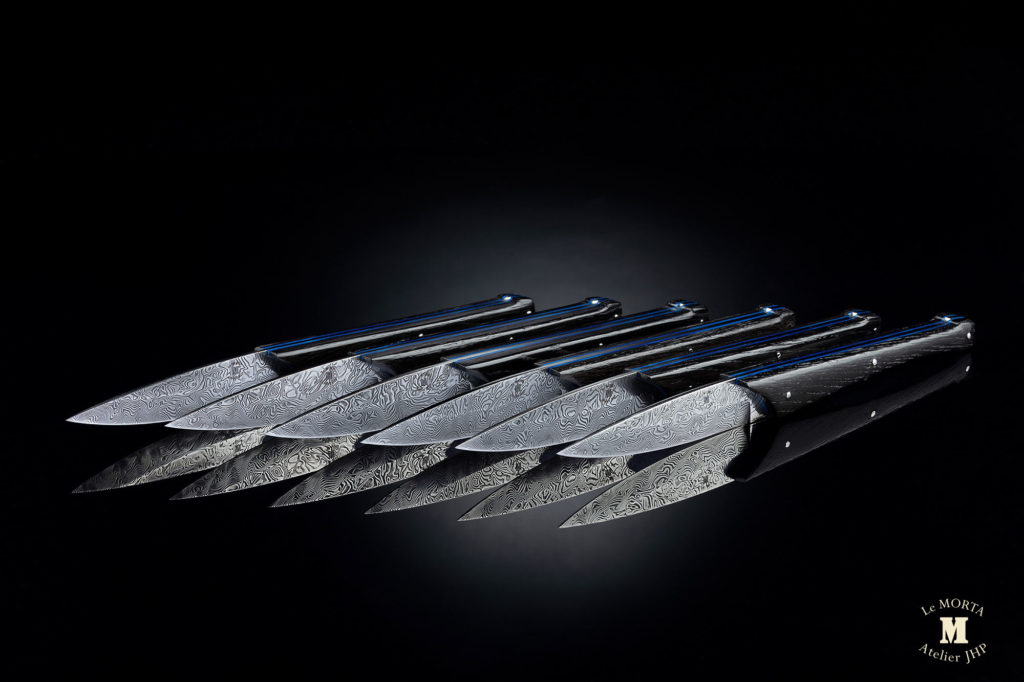The invention of the table knife coincides with seated meals. In antiquity and up until the Middle Ages, diners ate lying down. The art of forging brought about specific knives, especially those for the kitchen. Then, the Renaissance placed the knife on the tablecloth next to the plate. Louis IV introduced the use of the fork, and cutlery gained refinement, becoming symbols of wealth and etiquette. Who rounded the blade of the table knife, Richelieu or Philippe le Bon? History hesitates. Nevertheless, while utility knives remained in the kitchen, table knives diversified. From meat to fish to dessert, an invention of an adapted blade for each dish. As for table setting, customs diverged between France and across the Channel.
Kitchen knife: From gallo-roman times to the middle ages
The history of the knife begins with the first tools made by Homo habilis in the Stone Age. But tables weren’t a concern back then! Flint, polished stone, copper, bronze, iron, and wrought iron passed through the centuries with the sedentarization of the human species.
As techniques improved, knives met specific needs. Blades served as swords and daggers. The Gallo-Roman period introduced kitchen and utility knives.
During the Middle Ages, lifestyles changed. Respected for their art, blacksmiths began making knives specifically for cooking. The knife was used for slicing large bread loaves (a tranchoir) which served as plates. But, other knives emerged: the bread knife, the small coustel, the wood cutter, the oyster knife, the chopping knife, the rocking chopper, and the penknife. The era of Christianity gave birth to Lent, Easter, and Pentecost knives.
The folding knife became popular in the late 15th century.
Medieval feasts limited utensils to knives and spoons. Men arrived at meals with their knives and carved meat for their wives. Tablecloths served as napkins.
Tell me the story of the knife
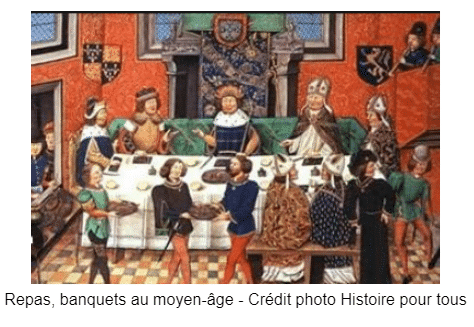
Invention of the table knife: The renaissance sets the table
Table cutlery: Symbols of wealth
The term ‘couvert’ appears during the Renaissance. The grand medieval tables slowly give way to more refined practices. The Renaissance, originating in Italy, reintroduces literature, philosophy, and all the arts of Greco-Roman antiquity. It notably marks the transition to refined manners at meals.
Previously commonly called kitchen utensils, cutlery reflected the owner’s social class. Indeed:
🔪 The nobility had gold cutlery;
🔪 Aristocrats had silver cutlery;
🔪 The poor used wooden cutlery (made of Morta 😉?).
There is ambiguity about the real meaning of the term ‘couvert.’ Several versions exist.
The ‘couvert’ could correspond to:
- the case covering the fork, knife, and spoon;
- the lid that kings placed over the plate filled with food to protect themselves from poisoning risks.
Apparently, at that time, nobody spoke about Morta cases 😉.
-

Case for folding knife
45,00 € This product has multiple variants. The options may be chosen on the product page -

Sheath for folding knife
45,00 € This product has multiple variants. The options may be chosen on the product page -

Sheaths for fixed knives
45,00 € This product has multiple variants. The options may be chosen on the product page -

Knives Storage Roll
125,00 € This product has multiple variants. The options may be chosen on the product page
The fork struggled to find its place on the table
François I (1494-1547) organized royal banquets at Château de Chambord and popularized the use of plates. Very wide-bladed knives were used to delicately place the meat on the platter.
History does not say which knife François I carried at Marignan…
Catherine de Medici’s dowry (1519-1589) included a two-pronged fork. This new utensil did not convince her husband, Henry II, who found it more practical to eat with his fingers. The use of the fork would wait until Henry III (1551-1589), but especially Louis XIV.
Many gentlemen stuck to the good old finger usage. To their defense, the fork was reputed to be a devil’s tool that encouraged gluttony: one of the seven deadly sins. Enough to discourage the most daring.
At the end of the 17th century, Louis XIV (1638-1715) encouraged refinement and finesse in table setting, a sign of wealth and etiquette. Royal families and nobles engraved their coats of arms on the backs of cutlery.
European courts and American colonies quickly followed suit.
Invention of the round-bladed table knife: Historical enigma
Between Richelieu and Philippe le Bon, opinions differ and historical accounts waver.
Cardinal Richelieu
Some attribute the invention of the rounded blade to Louis XIII’s minister, Cardinal Richelieu (1585-1642). A refined man, he wished to put an end to unrefined manners. Indeed, aristocratic guests (especially Chancellor Séguier) regularly cleaned their teeth with the knife’s point. This habit exasperated our Eminence.
“Too many men, who were pillars of royal power, have been killed in noble quarrels.”
Cardinal Richelieu
Concerned about the lives of nobles and aristocrats, the cardinal prohibited duels, which he described as knife-fighting contests. These conflicts sometimes arose during banquets, which is why the arrival of round-bladed knives is attributed to him.
The cardinal imposed on the king’s cutlers the manufacture of knives with rounded blades. Here again, history hesitates about the date of this decision. Some refer to the edict of May 13, 1610, while other experts place it on May 13, 1637. It’s worth noting that May 13, 1610, is the day of Marie de Medici’s coronation.
1610 is also the year of King Henri IV’s regicide assassination by Ravaillac on May 14 (he was killed by stabs, certainly not with a round-bladed knife).
Or Philippe le Bon
This version is contested by the discovery of a round-bladed table knife decorated with the arms of Philippe le Bon (1396-1467). This piece of medieval goldsmithing shows the collar of the Order of the Golden Fleece and the motto: Aultre naray (no one else will).
Philippe le Bon adopted this maxim after his marriage to Isabelle of Portugal in 1429. It is a steel knife, copper-gilt, with wood and enameled silver trim. The embossed leather case contains two knives.
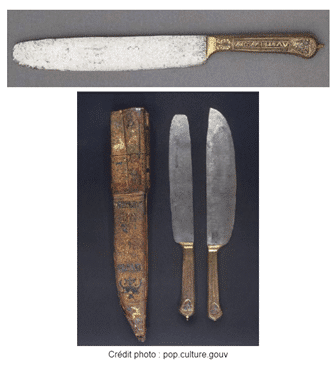
Years go by, and the knife never leaves the other utensils, even during picnics. James Tissot and Monnet testify to this through painting, notably with the famous Luncheon on the Grass.
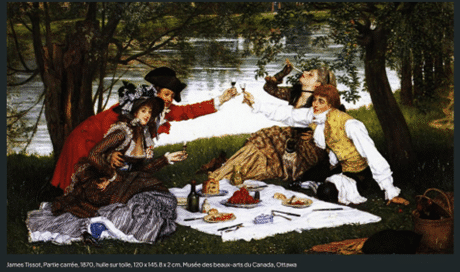
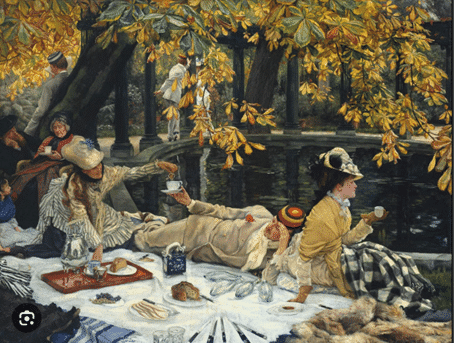
James Tissot: Picnic
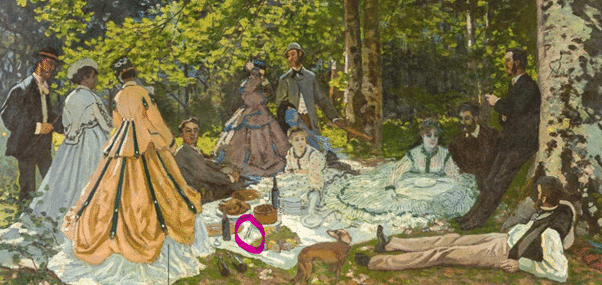
Monet: The Luncheon on the Grass
Contemporary table knives
As history progresses, cutlery innovates, and knives become more specialized. They come in as many versions as there are products to be cut.
🔪 The appetizer and dessert knife (wash it between the two courses 😉). Smaller than the standard flat knife, it has a rounded tip and a less sharp blade.
🔪 The flat knife: the most common. Its pointed and sharp blade easily cuts meat.
🔪 The steak knife slices thick meat.
🔪 The utility knife, despite its name, fits perfectly to the right of the plate.
🔪 The folding knife appears on many French tables, as well as on picnic blankets.
🔪 The fish knife resembles a small spatula. Its slightly curved and pointed blade easily separates bones from flesh.
🔪 The round-tipped knife is very dull. It spreads and spreads.
🔪 The butter knife comes in various sizes, especially with a short handle.
🔪 The cheese knife is placed with the dish, not around the guest’s plate. Its curved and forked blade allows you to spear the piece of cheese to bring it to your plate. For cheese lovers, various shapes adapt to hard or soft cheeses.
🔪 The bread knife stays in the kitchen for formal meals. Casually, it is made available to guests on the cutting board.
🔪 The oyster knife stays in the kitchen. Its blade is short and very pointed to facilitate the opening of the shellfish.
Setting the table: Where to place the knives?
The french table
While the majority of French people prioritize practicality with their cutlery, table manners impose precise rules.
Classic cutlery arrangement according to French tradition.
🔪 To the right of the plate: soup spoon (convex side up), fish knife, meat knife, oyster fork, and snail fork.
🔪 To the left of the plate: other forks, tines pointed towards the tablecloth.
🔪 In front of the plate: cheese knife, dessert spoon, forks, and small knives (for desserts). Upscale establishments bring these with the dish. The knife handle to the right, disregarding left-handed people who use what our ancestors called the “wrong hand.” Nowadays, it is common to do the opposite if you know the guest is left-handed.
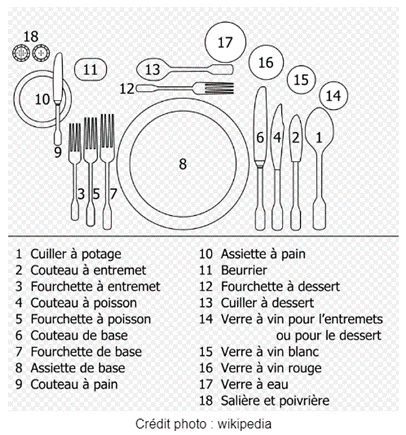
Cutlery is arranged in order of use, the outermost first.
French tradition dictates that the table setting should not exceed 3 pieces.
For a formal meal, avoid knife rests, which imply that you don’t plan to wash the tablecloth😉.
How to place your table knife?
The cutting edge of the knives is placed towards the plate, out of consideration for the neighbor who might feel threatened if the blade were turned towards them.
In France, silversmiths engrave their monogram on the back of the cutlery. And the knife makers?
If you bring out your finest engraved knives, don’t hesitate to proudly display the precious engravings.
🔪 At Couteaux Morta:
- the logo of the JHP workshop appears on the blade 😉;
- your personalized engraving
– on the side opposite the logo for stainless steel blades;
– on the heel for Damascus and raw forged blades;
– or on the back of the blade. The addition of a pictogram can also be positioned to the left or above your personalized engraving.

Personalized engraving: 2 letters and 1 pictogram on a Damascus blade

Personalized engraving on a Raw Forge blade

Personalized engraving and 1 pictogram on a stainless steel blade
A pictogram, simply? Certainly not! Engraving a handmade knife is quite an art!
Placemats: Knives that delight guests
Want to please your guests or simply set a beautiful table? Couteaux Morta offers sets worthy of the grandest ceremonial dinners. By 2 for lovers or by 6 for family or friends gatherings, which one will you choose?
However, during a picnic among friends, the Morta knife takes its place without concern for conventions. Laid out on the ground, passed from hand to hand, it doesn’t matter. Some have even spotted it on the car hood between two sausages and a loaf of country bread.
How do you present your Morta knife?
The english table
Let’s not forget British etiquette!
English tradition dictates that knives are placed to the right, with the edge towards the plate. The convex side of the spoon faces the tablecloth. Glasses are arranged from left to right, in descending order of size.
Forks are placed to the left, with tines up so that guests can admire the crests inside. Isn’t it nice?
Since the Renaissance, the table knife has continued to take its place on tablecloths and in the hearts of the French. For every dish, there’s a blade; for every guest, their habits. Isn’t the essence of the meal the sharing of a moment of friendship around a well-filled plate? What do you think, friends?
And to garnish your table with delicious wild plants, why not go shopping in nature?
Article written by the sharp pen of Christelle Lorant.
Our sources – L’histoire par l’image
FAQ – Summary of the article
How and why did the table knife evolve from the Renaissance?
The evolution of the table knife since the Renaissance reflects cultural and social transformations in table manners.
During this period marked by a revival of arts and sciences, table cutlery becomes symbols of social status. The nobility equipped themselves with gold cutlery, aristocrats with silver, while less affluent classes used wooden ones.
This diversification symbolizes the distinction between social classes and introduces new ways of eating, favoring the use of the fork and the gradual abandonment of the habit of eating with fingers. The table knife, especially with a rounded tip, becomes a refined utensil, reflecting the evolution of table manners.
What significant contribution did Cardinal Richelieu make to the design of table knives?
Cardinal Richelieu made a major contribution to the design of table knives by initiating the invention of the round-tipped knife. This innovation aimed to promote a more refined etiquette at the table, putting an end to the unrefined use of the knife point to clean teeth. History does note, however, that round-tipped knives already existed under Philippe Le Bon.
With this measure, Richelieu also aimed to reduce the risk of injuries during duels, which were frequent at the time.
The introduction of round-tipped knives thus symbolizes a turning point in table manners, combining elegance with safety.
How did the fork play a role in the evolution of table cutlery?
The fork played an essential role in the evolution of table cutlery by changing eating practices. Initially viewed with skepticism and considered a tool that encouraged gluttony, its reputation changed under Louis XIV, who encouraged its use to reflect the refinement and sophistication of the French court.
The fork then became a symbol of the evolution of customs and culinary practices, marking a transition to more elaborate meals and particular attention to etiquette.
What is the importance of different types of table knives in contemporary cutlery?
The different types of table knives in contemporary cutlery illustrate the specialization and adaptation of tools according to specific culinary needs.
From the meat knife, designed to slice efficiently, to the dessert knife, with a
rounded tip for versatile use, each knife serves a specific type of food or function.
This diversity reflects the importance given to the culinary experience, where every detail is designed to enhance tasting and ease of use.
How do the materials and design of table cutlery reflect social and cultural changes throughout history?
The materials and design of table cutlery directly reflect social and cultural changes throughout history. The use of different materials, such as gold, silver, and wood, illustrates not only the social status of users but also the evolution of manufacturing techniques and aesthetic standards.
The design of cutlery, such as the appearance of round-tipped knives or the democratization of the fork, marks the evolution of table manners and the increasing consideration of ergonomics and safety.
These transformations are a testament to cultural adaptations to eating practices, the social symbolism of cutlery, and the importance given to the experience of shared meals.


